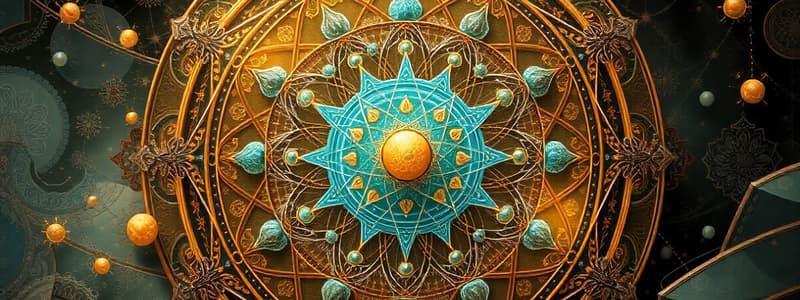Podcast
Questions and Answers
Matter is composed solely of quarks.
Matter is composed solely of quarks.
False
Protons and neutrons are components of atomic nuclei.
Protons and neutrons are components of atomic nuclei.
True
Electrons orbit the nucleus and don't contribute to the atom's charge.
Electrons orbit the nucleus and don't contribute to the atom's charge.
False
Solids have a definite shape and volume.
Solids have a definite shape and volume.
Signup and view all the answers
Gases are highly compressible.
Gases are highly compressible.
Signup and view all the answers
Melting is the transition from gas to solid.
Melting is the transition from gas to solid.
Signup and view all the answers
Sublimation is the transition from solid directly to gas.
Sublimation is the transition from solid directly to gas.
Signup and view all the answers
Physical properties of matter can only be observed through chemical reactions.
Physical properties of matter can only be observed through chemical reactions.
Signup and view all the answers
The arrangement of particles determines the state of matter.
The arrangement of particles determines the state of matter.
Signup and view all the answers
Study Notes
Fundamental Particles
- Matter is composed of fundamental particles, including quarks and leptons
- Quarks combine to form protons and neutrons, which are components of atomic nuclei.
- Leptons include electrons, which orbit the nucleus and contribute to the atom's charge.
- Other particles like photons mediate forces between particles.
Atomic Structure
- Atoms are the basic building blocks of matter
- Atoms consist of a nucleus containing protons and neutrons
- Electrons orbit the nucleus in specific energy levels.
- The number of protons defines the element.
States of Matter
- Matter exists in three fundamental states: solid, liquid, and gas.
- The state of matter is determined by the arrangement and movement of the constituent particles.
Solids
- Solids have a definite shape and volume.
- Particles in solids are tightly packed and have fixed positions.
- Solids have strong intermolecular forces.
- Solids can be crystalline (ordered structure) or amorphous (disordered structure).
- Solids are characterized by low energy and low particle motion.
- Examples of solids include ice, rocks, and metals.
Liquids
- Liquids have a definite volume but no definite shape.
- Particles in liquids are close together but can move past each other.
- Liquids have weaker intermolecular forces than solids.
- Liquids take the shape of their container.
- Liquids flow and have fluidity.
- Examples of liquids include water, oil, and mercury.
Gases
- Gases have neither a definite shape nor a definite volume.
- Particles in gases are widely spread and move randomly at high speeds.
- Gases are highly compressible.
- Gases have very weak intermolecular forces, allowing the particles to move freely and occupy a large volume.
- Gases fill the container in which they are placed.
- Examples of gases include oxygen, nitrogen, and carbon dioxide.
Phase Transitions
- Matter can transition between solid, liquid, and gas states through heating or cooling.
- Melting is the transition from solid to liquid.
- Boiling (vaporization) is the transition from liquid to gas.
- Freezing is the transition from liquid to solid.
- Condensation is the transition from gas to liquid.
- Sublimation is the transition from solid directly to gas (without a liquid phase).
- Deposition is the reverse of sublimation (gas to solid).
Properties of Matter
- Physical properties of matter describe characteristics that can be observed or measured without changing the substance's chemical composition.
- Examples of physical properties include density, color, boiling point, and melting point.
- Chemical properties relate to a substance's ability to undergo a chemical reaction or change its chemical composition.
- Examples of chemical properties include flammability, reactivity with acids, and oxidation.
Studying That Suits You
Use AI to generate personalized quizzes and flashcards to suit your learning preferences.
Description
This quiz explores the fundamental particles that make up matter, including quarks, leptons, and their roles in atomic structure. Additionally, it covers the different states of matter—solid, liquid, and gas—and their properties. Test your understanding of these core concepts in physics!




